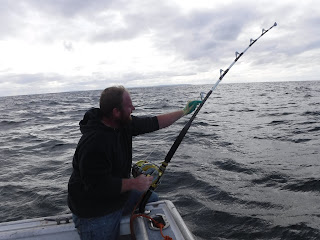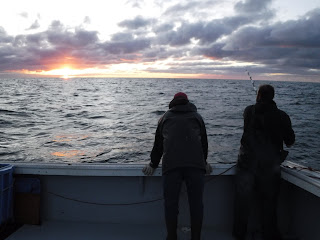The focus turned from tagging large bluefin with satellite tags
in US waters to getting out surgically implanted archival tags in
high numbers today- and to help us achieve our mission- our Mexican
colleagues at Baja Aquafarms of Ensenada, Mexico- contributed 32
fish ranging from 40 to 70 lb fish for tagging. We came to some tow
pens maintained by the famr early in the AM, that had beautiful f2016
captured fish circling-that had been caught about a month earlier.
The fish were already feeding and looked quite well. To catch the
fish we used lift poles- manned by two of the crew, and with the help
of their divers and some members of our team- we coordinated the
capture of the fish in a sling, the removal of the hook, and the
transfer to the archival tagging station. The entire operation took
less then two hours (30 fish tagged), and was orchestrated from start
to finish with well coordinated steps. Fish were caught on a barbless
hook by Charlie, Aaron and Renne, then moved to a sling manned by Dr.
Daniel Madigan. Dan managed to keep the fish in the sling with some
water along with two divers assisting and passed off the fish to
teammates waiting on deck led by Dr. Luke Garnder. Luke's team
managed to bring the fish to the tagging station and were greeted by
Drs. Dale and Block, and TAG scientist, Mr. Robbie Schallert.
Together this team placed a surgical archival tag in the fish, took a
sample of muscle for mRNA, and DNA samples, and completed the process
in quick succession 30 different times! All fish looked good and what
made the entire team happy- is that just as we pulled away from the
pens- the captain sited more wild fish- and we within the space of an
hour tagged a few more of the same size class in the pen. It was a
glorious moment- to get about 32 tags out- and all on 3-4 year old
fish. These tags will last up to six years in the wild taking high
resolution data. And have the promise of showing how these fish
mature- the ontogenetics of their changing behavior and the route to
the various spawning grounds. Their only fault is that we need to get
the tags back!
-Barb























